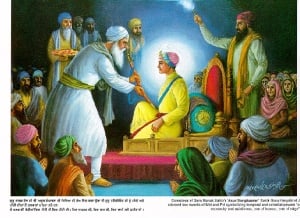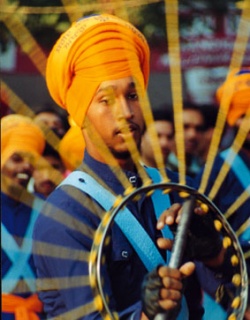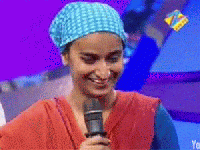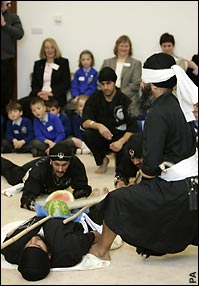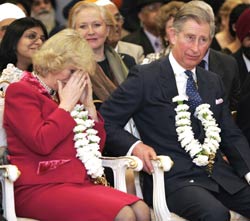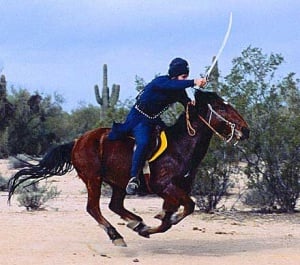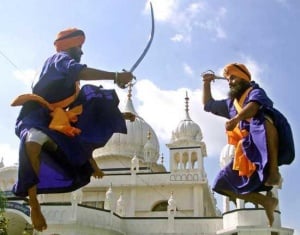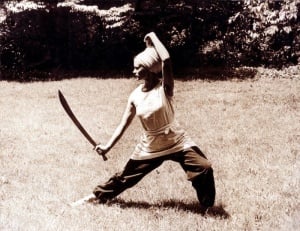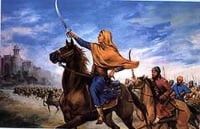Gatka
Gatka is an ancient martial art which has been thoroughly battle-tested and has existed in northern India for many thousands of years. It is considered to be a spiritual as well as a physical exercise. Both these aspects of the person are developed to a high level during the learning phase in this ancient art. Although it uses the sword as its primary weapon, many other weapons are available to the Gatka master. Today, this art exists exclusively amongst the Sikhs who have passed down the flamboyant techniques through generations, since their sixth Guru, Guru Hargobind wore the two swords of Miri (temporal, worldly) and Piri (spiritual, transcendental).
The Sikhs have been responsible for the revival of this early art ensuring it's survival despite mass persecution of the native population in India by foreign invaders like the Mughals and others for many hundreds of years.
Gatka is a complete martial system which uses spiritual, mental and physical skills in equal portions to help one fully competent in defending themselves and others. It is a system that can only be used in defence as per:
| "When all other means have failed, it is proper to take the sword in one’s hand", |
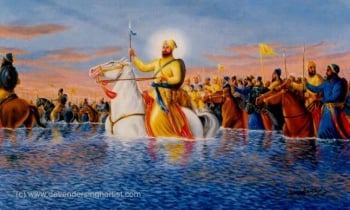
In addition to giving the student defensive skills, it also helps the individual with other aspects of their life: makes the mind alert and responsive, maintains the body in a near perfect condition and makes soul fearless, compassionate and tranquil.
The techniques involved are extremely effective for defence and attack as well as visually spectacular. The Sikhs mastered Gatka and perfected its use in battle. Many battles were won by the Sikhs, despite almost always numbering far fewer than the opposite forces. The techniques within Gatka were combined with the spiritual practices of the Sikhs to create a perfect fighting system. Opposing forces have documented how awesome these Sikhs were at battle!
The art of Gatka involves a series of integral combat training systems that include several systems of duels armed - unarmed and the use of weapons of defense and offence. It aims at the coordination of mind & body through the meditation of spiritual verses of Gurbani, a holistic system by which the character and moral attitude of a student is shaped.
In the News
Rashpal Kaur Performs Gatka on Zee TV
After a memorable performance by on Zee TV last year, Rashpal Kaur - a young girl from Chandigarh - has recently performed Gatka on Zee TV's Dance India Dance - reality show.
The judges were not only taken aback by her performance, but also by the adversity she had experienced. Rashpal discovered that she had a life threatening brain tumor when she was pregnant. The treatment she received took away her vision but she was able to deliver a healthy baby boy.
As an ancient martial art, Gatka is considered a spiritual as well as physical exercise. It’s an inspiring example of how one can turn pain into something much more powerful. You can view Rashpal’s performance after the jump.
“I only wished that I could see my son once. I just ask God to lend me my eyesight back for just for three hours so that I can see my child just once,” Rashpal said. But this is one wish that has never got fulfilled for Rashpal.
Rashpal said she is thankful to Dance India Dance for helping me to reach out to so many people. The citizens have shown so much concern and care for me. Before I die I want to do something for my guru Kuljeet-ji and his martial arts school where he teaches young girls about self defense. In today’s times when women are being molested and victimized every other day, I want all the women to learn this martial art form to defend themselves and their
Prince Charles and Princess Camilla
This section from: www.telegraph.co.uk
As a relative newcomer to the Royal Family, the Duchess of Cornwall can be forgiven for still being shocked by the often wonderful and bizarre sights that go with official duties.
However, even such an old hand as her husband looked mildly alarmed at the sight of a blindfolded Sikh swordsman slicing through a melon on a man's stomach.
But the hair-raising climax of a spectacular martial arts display laid on for the royal couple proved too much to bear for the duchess.
As the critical moment approached, to the roll of drums, she held her hands over her face and averted her eyes.
Even the Prince of Wales gripped the arm of his chair as the scimitar flashed.
In the event, the melon was halved with perfect precision and the man on the floor rose to reveal he had not received a scratch.
The blindfolded swordsman, Uptej Singh, a 42-year-old IT engineer who had warmed up by slicing bananas held by his colleagues, later made the prince laugh when he advised him: "Don't try this at home."
The event marked the festival of Hola Mahalla, when Sikhs practise military exercises and stage mock battles to emphasise their warrior credentials.
The couple, who go to India in a fortnight, were visiting the Gurdwara Sri Guru Singh Sabha in Hounslow, west London, to mark Commonwealth Day.
After the display, the prince joked: "I'm so glad that the Health and Safety Executive have managed to clear the way in which this extraordinary demonstration was carried out."
The visit to the Gurdwara began predictably enough.
The couple arrived at the temple to be greeted by hundreds of excited schoolchildren waving Union flags. They were given garlands of white flowers to wear.
Inside the temple, they removed their shoes and put on headgear as they briefly visited the prayer room to pay respect to the Sikh scripture, the Guru Granth Sahib.
At the end of the visit, they sat down to watch the traditional Sikh martial art, Gatka - which dates from the early 17th century - performed by the Baba Fateh Singh Gatka Akhara, from Leyton, east London.
The 14-strong group, whose youngest member was only five, demonstrated Gatka moves with sticks. Then more experienced members staged mock duels with large ceremonial swords called kirpans.
The team, whose members include a chiropractor, an engineer, a police officer and a teacher, travel the world demonstrating the ancient art.
Gatka was originally practised by the Sikhs in the Punjab to defend themselves against the Mogul invaders.
According to its adherents, it is so effective that when the Golden Temple was attacked in 1984 by the Indian Army, four Sikh warriors stood at the doors swinging their swords in a Gatka movement and no Indian soldier could get close to them.
Introduction
Gatka is the traditional martial art of the Sikhs. It is based on the basic principle of unification of the mind, body and spirit in a rhythm of life to train a saint-soldier to be able to defend himself or herself.
When learning the art, you go from bare handed combat to using various shastars (weapons) such as kirpans, sticks, lathis, marotis, nun chucks, axes and a lot more.
The first shastar that a student will use is a stick normally made out of bamboo, sometimes called a Marati. With the stick you are taught all of the basic physical movements and the mental attitude required. Once these techniques have been learnt then these can be applied with other shastars as you gain more experience.
Kirpans type Shastars come in different shapes and sizes and can also come in different styles. Some the kirpans that are used by practitioners are: Talwar, Gurj, Standard, Thega, etc. Once the various techniques have been mastered, you go onto to sparing with shastars and this is when you will then be introduced to shields. Shields come in many forms and shapes. They vary a lot – some are large and heavy; some have spikes on them for attacking; some are very basic and are only used for defence only.
Sparing is a completely different level of functioning. It can be very dangerous sparing with kirpans and axes and requires strict discipline, concentration, clartity of mind and restrain. Some shastars are not used in action but are worn by the practitioner for defence. These are either placed in our "kamar kasa" (belt) or around our dastars (Turban) such as a "chakar" (metal ring).
Some instruments used in war were not even weapons such as the Ranjit Nagara, the drum of victory, was used to boast the morale of the Sikhs going to battle, during battle and coming out of battle. Even Bani was used to help in battle the soldiers during wars. Gurbani helped even the weakest Sikhs to fight heroically. The Bani, Shastar Mahma from the Dasam Granth is one such Bani.
Meaning of Word ' Gatka '
According to 'Mahan Kosh' edited by Kahan Singh Nabha, 'Gatka - a three-hand span stick, used to teach the first part of club fighting. It has a leather covering. In the right hand holding a Gatka and in left hand a 'Phari', two men play with each other. Persian - Khutka. (See 'Mahan Kosh').
Thus, Kahan Singh Nabha believes that the words 'Khutka' and 'Gatka' are used for same meaning.
When we seek advice from 'Urdu-Punjabi-Hindi Kosh' published by the Language Department, Punjab for word 'Khutka', we find these meanings with other: - 'Kutka', 'Mota Danda' (motw fMfw) (cudgel), 'Thhosa' (Tosw) (thumb) etc.
Therefore, according to this 'Urdu-Punjabi-Hindi Kosh', the word 'Khutka' is synonymous with 'Kutka'.
The word 'Kutka' has been translated into 'short cudgel' by 'Punjabi English Dictionary' Published by Singh Brothers, Amritsar.
According to 'Mahan Kosh' edited by Kahan Singh Nabha, 'Kutka' is 'Chhota Ate Mota Sota' (Cotw Aqy motw sotw) (short thick stick).
Let us again consult 'Punjabi English Dictionary' Published by Singh Brothers, Amritsar, this time for word 'Gatka'. According to this dictionary, the word 'Gatka' stands for 'a leather covered club used in fencing'.
According to 'Standard Illustrated Dictionary of The Hindi Language' compiled and edited by Prof. R. C. Pathak, the word 'Gatka' means 'a leather-covered club used in fencing, a truncheon, a mace, a club.’
According to 'Standard Illustrated Dictionary of The Hindi Language' compiled and edited by Prof. R. C. Pathak, the word 'Gadaa' means 'a club, an Indian club, a mace'.
Thus, comparatively the terms 'Khutak', 'Khutka', 'Kutka', 'Gatka', 'Gadka', ‘Gadd’ and 'Gadaa' are close to one another, if not completely the same. These words are translated into 'Mota Danda', 'Chhota Ate Mota Sota', cudgel, truncheon and club.
There could be many kinds of 'Kutka' or 'Gatka' depending on their size or shape.
This can be compared to 'Khanda' and 'Talvaar'. Both words have been used for sword. At the same time, the word 'Khanda' is used for a particular kind of double-edged sword also. In the same way, 'Saif' is a sword, but of a different kind.
Well, after this discussion given above, we reach conclusion that the word 'Gatka' stands for cudgel, club or short thick stick.
Comparatively the terms 'Khutak', 'Khutka', 'Kutka', 'Gatka', 'Gadka', ‘Gadd’ and 'Gadaa' are closer to one another, if not completely the same. These words are translated into 'Mota Danda', 'Chhota Ate Mota Sota', cudgel, truncheon and club. The word Gatka is of Indian origin. The martial art, in which Gatka is used as a weapon, is called Gatkabaazi. Because the main weapon used in this martial art is Gatka, so people often call this martial art Gatka itself, instead of Gatkabaazi.
Now, it is very common in Sikh circles to use word Gatka for all traditional martial arts, in which traditional weapons are used.
Technique
The word Gatka actually refers to the wooden stick used in training called soti, which is equipped with a basket hilt. The entire martial art is based on the correct use of a vast array of melee (hand-to-hand) weapons. The foundation of the art is the Panthra which refers to the form, coordination and method for moving the feet, body, arms and weapons correctly, in unison. Gatka technique starts with a simple four-step movement called the Panthra. This is a balance and co-ordination exercise and is to be practised repeatedly. The movement requires equal and simultaneous use of both hands and makes one ambidextrous. This basic movement is followed when using all weapons and imparts impeccable balance to the practitioner.
Gatka is normally taught with rhythmic accompaniment, and the object is to achieve fluid, natural and flowing movement, without hesitation, doubt or anxiety. All the movements including attacking and blocking methods are all based upon the positions of the hands, feet and weapon(s) during the Panthra dexterity exercises. Many weapons are taught with special methodologies, in addition to the Panthra exercises.
The most common weapon used by Gatka exponents today is the lathi (a stick of varying length), but all of the other traditional weapons are still taught. Probably the most common combination of weapons in the hands of Gatka practitioners of today and in the past is the sword and shield. As one advances in their experience, they learn about the special "chambers" and other techniques, which are unique to certain weapons, such as the khanda (two-edged sword), the tabar (axe) and the barcha (spear).
The panthra exercise is a flowing, non-stop movement, and there are no specific preset "moves" similar to say, karate in Gatka. Rather, the methods of moving, turning, stopping, attacking and defending are learnt and the application depends on the circumstances at the time. The panthra exercise is practised at the same time as the Jaap Sahib Bani prayer is being sung. Also, a three-beat-per-cycle is played by a drummer at the same time. This assists in developing natural and flowing co-ordination. Just like the various "beats cycles" in Jaap Sahib, advance Gatka incorporates these different cycles and rhythms.
Art
In its physical form , Gatka is the original feudal art of the Saint Soldiers "Khalsa", for whom the way of life is the same as the art of war. A separate entity from the art of mere fighting, its a way of life. The balance of fighting skills, religion, healing and philosophy are the elements which consolidate into this great martial art. Any martial tradition ("Bir Bidiya"), skill, belief or art which is not beneficial to both the exponent and society is not a martial art, the following must exist:
- Disciplined training
- A moral philosophy
- Dedication and a sense of duty and respect, where a balance and understanding of both cultural and martial ways is established.
Through its own evolution and efforts of a group of Instructors and schools ( Akhara's ) around the world, it has progressed through the years to its present position as a martial art of great valor. Its theory, techniques and methods have been handed down through the centuries and today have been molded into an art with all of the action and history of the past contained within its present training. It is practiced in a way that it proves useful at any time and is taught in a way that it is useful in all walks and duties of life.
The Spiritual attributes of this art are instilled with the realization that one is participating in an art developed by spiritual warriors who possessed great valor, honesty and integrity, including the principles and traditional concepts laid down by great saints, bhagats, peers of various religions, and the Sikh Gurus of the Sikh religion.
The martial mind, the discipline, the focus of the truth all elements of the MIND, the principles laid down for the warrior/practitioner/mankind is that the personality of ones self is a temporary alliance of wants and desires, (The material) and that life it self is no more than an illusion (The dream) , one can aspire to no greater heights than to die gloriously for the truth. To die is a metaphor which relates to all aspects of life from the daily duties as a citizen of a country , a noble, a peasant, a king, a parent, a soldier or a saint. The duties of the saint soldier has no margin in the way of life. The principles are all the same in any field and walk of life for all mankind. The prime objective, achieving a balance of the outer and inner elements. The ultimate, to die fighting in the field of battle.
| "They alone are truly and fully live on this earth who remember the Lord and are ready to fight for the righteous cause. Brittle is our body; it does not last long. Let us use it and get into the boat of YASAS (nobly earned repute) and cross the ocean of repeated births and deaths. Let us make this body the residence of forbearance and fortitude and light in it the excellent lamp of wisdom. Let us there-after hold in our hands the sword of knowledge-realisation (Gnana) and bravely destroy with it, the demon of cowardice in us." |
| "Khalsa lived poised in sword's sharp edge, and he kissed its cold steel. Indeed Iron had gone into his soul at his nativity. But it would be a great mistake to associate the Khalsa with the wanton wars and bloodshed. he took to the sword because of a crisis of conscience." |
Maharaj Guru Gobind Singh
Extracts taken from : Leadership in its Finest mould - Guru Gobind Singh By Colonel Ravi Batra
Gatka During Gurus' Period
- Baba Budha Ji who witnessed the period of Sikh history from Guru Nanak to Guru Hargobind trained an army of Sikhs, called the Akali Sena or Budha Dal in Gatka.
- 6th Guru., Shi Guru Hargobind Ji The sixth guru led a soldierly life to infuse the spirit of self respect & honour among the hapless peasants, habituated to living as slaves for centuries & exploited by the Mughal invaders. During his time Gatka warriors successfully defended the Golden Temple of Amritsar from a Mughal siege.
- 9th Guru, Sri Guru Tegh Bahadar Ji was supposedly seen practising Gatka alone by the Mughal army, his speed and accuracy was both an alarming and surprising experience for them.
- 10th & last Guru. However the real lift of Gatka began in his son's time Sri Guru Gobind Singh Ji who is and was described as the most perfect person on earth, as he was very intelligent and could speak and write a number of different languages with equal comfort. He was spiritually blessed by his father and had great athletic abilities. He was known as the greatest master of weaponry of his time and it is assured that he was taught Gatka by his father and his followers from a very young age. His ability was much admired by his army of followers and to this day the fact that he and his army fought and won so many battles against countless numbers of Mogul soldiers with a very limited amount of men and weapons, to this day leaves historians all over the world surprised.
- 10th master established the Khalsa (brotherhood) tradition, which unified the Sikh community into a powerful fighting force. He appended Ninth Guru, Guru Tegh Bahadur's teachings to Adi Granth. Thus updated Adi Granth, was given the formal socio spritual status of the 'ONLY Guru' for the entire HUMANITY for times to come, by him.
- The Sri Guru Granth Sahib on date is enlightening & guiding not only Sikhs of the world alone, but all other seekers as well on the path of Truthful Living. It radiates universal love for each other as nothing but Human Beings, under the unseen (but not unknown) control of One Lord TRUTH. Compilation of 'Sarab Loh Granth' and the 'Dasam Granth' are other two works of his times.
The Shastars
Below is a list of some common Shastars (Weapons) used in Gatka:
- Barcha — The spear is a long shafted weapon and has a hook at the spearhead used to pull away the opponent's shield.
- Chakram - The chakram is a flat steel ring, five to 12 inches in diameter, from half an inch to an inch and a half wide, and with a sharp outer edge. While not being used, it is carried "fixed" to the Turban. Several of different sizes were often carried on a pointed turban, the "dastar ungaa" or behind the back. It is held between the thumb and index finger and thrown towards the opponent with an underhand flick. Thrown with sufficient force and accuracy it can cut off a green bamboo three-quarter of an inch in diameter at a distance of thirty yards.
- Dahl or Shield. It is nearly always round and varies in diameter from about eight inches to about twenty-four. Some are very nearly flat while others are strongly convex. The edges may be flat or rolled back in the reverse curvature of the shield. It is held by two handles fastened to ring bolds that pass through the shield and are riveted to bosses on the outside, sometimes formed to spikes. Between the handles there is a square cushion for the knuckles to rest against. The handles are so placed that, when tightly grasped, they force the backs of the fingers against the cushion giving a very firm and comfortable hold. These shields are nearly always of steel or leather.
- Gurj or Mace: Indian maces have great variations in their shape. From simply curved steel bars to Persian influenced maces with openings in the head which gives a whistling sound when the blow was struck to plane massive heads. They often have guard hilts like the Khanda
- Katar - The Katar is a double-edged and straight bladed dagger used to pierce armour. The handle has two sidebars to provide protection and a better grip.
- Khanda - This is a typical Indian sword and has a broad, straight blade, usually widening towards the point, which is blunt. Sometimes it is also double-edged.
- Kirpan - The Kirpan is a short curved dagger and all Sikhs are required to carry it by tradition.
- Lathi - The lathi or quarterstaff is a wooden stick as tall as the warrior and made of oak.
- Marati - Trainig device: The Marati is a bamboo stick with wooden or cloth balls on its ends. It is mainly used for training purposes but there are variations with blades or burning cloth on its ends, to attack and distract elephants and for psychological warfare.
- Soti - This is made from fire hardened bamboo or ratan, 1m long and usually has a hand guard. It is mainly used for practice and "playing Gatka", the training fight. For combat they were replaced by oak ore ironwood sticks, without hand guards.
- Tapar - The battle-axe is very distinct from the normal axe and sometimes has a dagger concealed in the handle.
- Talwar - The sword is usually curved with a thin and sharp blade. The Talwar is greatly respected and treated with care.
- Tir Kaman - The bow and arrow is a potent weapon. The arrow is made of steel heads with reed shafts. The bow is also composite and made of layers of wood and steel.
- Chakar - The Chakar looks like a wagon wheel with weights at the end of each spoke. The chakar is wielded by grasping the centre and spinning it around, causing damage upon anyone coming too close to the spinning weights.
History, Live & Kicking
Baba Budha Ji who witnessed the period of Sikh history from Guru Nanak to Guru Hargobind trained an army of Sikhs, called the Akali Sena or Budha Dal in Gatka. Traditional Sikhs called Nihangs, who stand by their outlook & attire of Gurus' times to this day, have carefully preserved this grand martial tradition. They are generally nomadic and are fully trained in Gatka, which they perform at fairs. This art is taught at Gurdwaras with the aim of keeping alive the historically prized soldierly spirit of Sikh Society.
The ninth Guru, Sri Guru Tegh Bahadar Ji was supposedly seen practising Gatka alone by the Mughal army, his speed and accuracy was both an alarming and surprising experience for them. However the real lift of Gatka began in his son's time Sri Guru Gobind Singh Ji who is and was described as the most perfect person on earth, as he was very intelligent and could speak and write a number of different languages with equal comfort. He was spiritually blessed by his father and had great athletic abilities. He was known as the greatest master of weaponry of his time and it is assured that he was taught Gatka by his father and his followers from a very young age. His ability was much admired by his army of followers and to this day the fact that he and his army fought and won so many battles against countless numbers of Mogul soldiers with a very limited amount of men and weapons, to this day leaves historians all over the world surprised.
As far as the Sikhs can recall Gatka goes back to about 1200 years, but some say it goes back a lot further? In the past few centuries, Gatka has mainly been practised in India by the Nihang Singhs, who are Sikhs who believe in the importance of preserving the type of dress (Bana) and weaponry as was worn by the Gurus. Their history is not very well known.
In the last 2-3 years Sikh Nihang, Bhai Nanak Dev Singh, an American who converted to Sikhi by the influence of Bhai Harbhajan Singh Ji -"yogi", has helped to spread Gatka around the world, especially around America and Europe. He has helped to write and publish a book in English called Gatka which teaches the basic's of this art. It is the first ever book about Gatka to be published anywhere in the world.
External Links
News Items
Debate at India's Got Talent- See videos
Other items
